by W. Cranshaw1 (6/13)
Quick Facts…
- European paper wasps do not produce nuisance problems around outdoor dining however they can sting.
- European paper wasps have become one of the most important natural controls of many kinds of yard and garden insects.
- The European paper wasp is a social insect that produces an annual colony in a paper nest. Individual colonies are established anew each spring.
- European paper wasps are sometimes mistaken for yellowjackets or hornets.
The European paper wasp, Polistes dominula, is a newly established insect now abundant in many areas of Colorado. The paper nests of this wasp are commonly observed in yards and gardens and the wasp is involved in stinging incidents. The European paper wasp develops as a predator of caterpillars and some other insects, populations of which have probably been affected by the establishment of this new wasp.
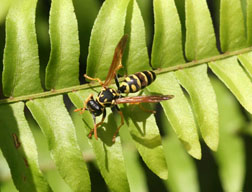 |
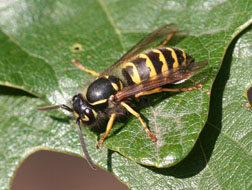 |
Figure 1. European paper wasp. |
Figure 2. Western yellowjacket, the most common species mistaken for European paper wasp. |
Description
The European paper wasp is a generally black insect marked with yellow. They are fairly slender-bodied insects with a distinct constriction of the body between the thorax and abdomen.
The European paper wasp is superficially similar to and commonly mistaken for various yellowjackets (Vespula spp.). Several yellowjacket species are native to Colorado and these historically have been the most significant stinging insects of the region. A somewhat blunter, more compact body form distinguishes yellowjackets from the European paper wasp. Also,
the long hind legs of paper wasps tend to trail below when the insects are in flight.
Background of Colorado Introduction
The European paper wasp is the common paper wasp of Europe. It was first found in North America in the 1970s in the Boston area. Since then it has spread rapidly to much of the northern half of the United States and British Columbia. The first Colorado record for the species is August, 2001 from Larimer County, and it likely entered eastern Colorado shortly before 2000. The first Utah record dates from 1995, suggest western Colorado may have been colonized earlier. Wherever it has established, the European paper wasp has usually become a common species within a few years. Currently it is now considered very abundant in every urbanized county in eastern Colorado and the three western Colorado counties of Mesa, Montrose, and Delta. Presently it is not thought to occur in much of the higher elevation counties, but is known in Steamboat Springs.
Life History and Habits
 |
Figure 3. European paper wasp gnawing on weathered wood. |
The European paper wasp is a social insect that produces an annual colony in a paper nest. Individual colonies are established anew each spring. The overwintering stage are females (queens), only slightly larger than the wasps typically observed during summer. Female wasps that were fertilized the previous fall survive winter in protected sites in and around a yard. When they emerge from overwintering shelters, they may be seen on warm days as they seek sites to establish new nests. Earliest activity is sometimes seen in the first half of March.
Nests are constructed of paper, produced from chewed wood fibers of weathered fences, porch decks and similar sites. Initially, a few hexagonal paper cells are formed and eggs laid in the cells. Upon hatch, the wasp larvae are fed crushed insects, usually caterpillars, that the overwintered queen discovers in foraging trips among nearby plants. When full grown the larvae then seal over the cell and pupate. Development of the wasps to the adult form is usually completed in 3 to 4 weeks after eggs are laid. The new wasps assist in colony activities of nest construction, foraging, and caring for young. The original queen increasingly remains restricted to the nest as new workers take over colony activities.
The colony continues to grow through the summer and may contain several dozen individuals by the end of summer. The nest is continuously expanded and reconstructed through the summer and may contain a hundred or more cells by fall. A few of the wasps produced later in summer are males and increasing numbers of the females become sexually mature at that same time. Mating occurs and the mated females are the surviving overwintering stage. Males and non-reproductive females do not survive winter and the nest is abandoned by late fall.
The fertilized overwintering females seek protected sites for shelter during the cold season. Often they find winter shelter outdoors but occasionally they will find suitable areas behind walls or in other areas of the house. These wasps sometimes will move about during warm periods and may find themselves within the living space. Such wintertime encounters do not indicate the presence of an active nest, only that some wasps have found some pocket of winter shelter within the building. Overwintered females emerge from these areas in spring and search out sites to establish nests in the neighborhood.
Nests are almost always established in new locations each year and several kinds of nest sites are particularly favored. (New nests sometimes are established at the same site the following year.) Dark cavities are often used, including those found in outdoor grills, large bells, pipes, rock cavities, and hollow spaces behind walls. Nests are also commonly attached to wood on the underside of porch decks, eaves of homes or other overhangs. Nests are almost always attached to either wood, roughened metal surfaces, or rock.
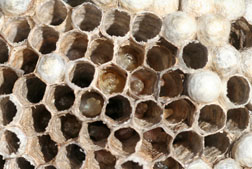 |
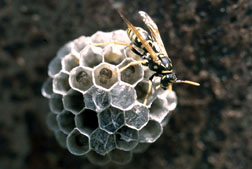 |
Figure 4. Developing wasp larvae and capped pupae. |
Figure 5. European paper wasp at nest. |
Paper wasp nests are not covered with a surrounding envelope of paper. Paper envelopes that surround a nest are characteristic of yellowjackets (Vespula spp.) and hornets (Dolichovespula spp.), the other social wasps found in Colorado. Yellowjackets nest underground or, occasionally, behind walls; hornets make conspicuous football-sized nests attached to branches or under eaves.
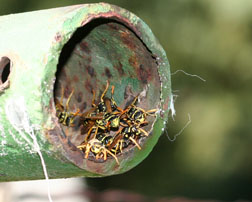 |
Figure 6. European paper wasps nesting in clothes line. |
The European paper wasp is capable of stinging. Among the stinging insects found in the state European paper wasp is relatively non-aggressive, and somewhat less likely to sting than are most yellowjackets and bumble bees. Stings from European paper wasp occur almost exclusively when nests are accidentally disturbed.
European paper wasps rear their young on live insects. They do not produce nuisance problems around outdoor dining that characterize scavenging species, such as the western yellowjacket. European paper wasps will sometimes feed on sweet materials, including honeydew produced by aphids. On rare occasions, they also may feed and damage ripe fruit. This habit is particularly notable in cherries and some other well-ripened stone fruits grown on the West Slope, where they may be serious pests.
European paper wasps have become one of the most important natural controls of many kinds of yard and garden insects. Most commonly they feed on caterpillars, including the larvae of hornworms, cabbageworms, and tent caterpillars. Sawfly larvae are also commonly taken prey.
(European paper wasps can be encouraged to nest in nest boxes. Artificial nest sites can be useful if one wants the benefits of these insects with a known nest location so accidental disturbances can be avoided. A typical nest box would be made of wood and at least 4-in x 4-in x 4-in, open at the bottom. They should be mounted several feet above ground on a solid post.)
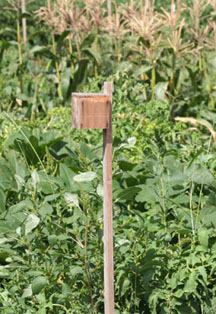 |
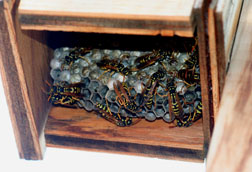 |
Figure 7. A nest box designed to house European paper wasp. |
Figure 8. European paper wasps in nest box. |
Control of European Paper Wasp
If nests are not in a location where they are likely to be disturbed, it is usually best to leave them in place. The nests will be abandoned at the end of the season and they then can be safely removed.
Individual nests can be destroyed. Insecticides are often used for this purpose and a wide variety of “wasp and hornet” marketed products are effective. If nests are treated it is recommended to apply treatments in the evening. At this time most of the wasps have returned to the nest so that they can be killed and, after dark, flying activities are greatly reduced.
After the nest has been killed it should be removed and destroyed. This will eliminate larvae that were within capped cells during spraying. These usually survive and later will emerge. It is also recommended that after a nest is removed the area also be washed with a jet of water to eliminate colony odors. These practices will inhibit surviving wasps, not present on the nest when it was destroyed, from attempting to reestablish a nest upon return.
There are no traps or lures that can be used to control this species. Commercially available ‘wasp traps’ are designed to attract certain kinds of yellowjackets and contain baits such as fruit juices, fresh meat, or heptyl butyrate (found in many retail wasp lures). None of these are attractive to the European paper wasp. There has not been any type of trap identified as effective for this species. (Large numbers of the native western yellowjacket, Vespula pensylvanica, and prairie yellowjacket, V. atripilosa, are captured by these traps.)
Other Paper Wasps of Colorado
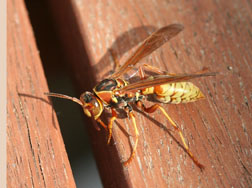 |
Figure 9. Golden polistes, Polistes fuscatus. |
Three other species of paper wasps are native to the state—Polistes fuscatus (golden paper wasp), Polistes apachus and Mischocytarssus flavitarsus (western paper wasp). There is no evidence that the new species has significantly affected their activities. In rural areas, away from buildings and human structures, these native paper wasps are the predominant species of paper wasp one will likely find. All of these other paper wasps have generally similar biologies to the European paper wasp.
 |
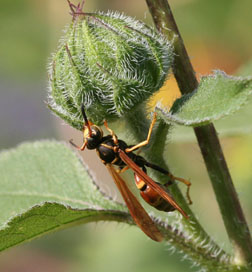 |
Figure 10. Polistes apachus, a native species of southeast Colorado. |
Figure 11. Western paper wasp, Mischocytarsus flavitarsus. |
*W. Cranshaw, Colorado State University Extension entomology specialist, and professor, bioagricultural sciences and pest management. 4/08. Revised 6/13.
Colorado State University, U.S. Department of Agriculture, and Colorado counties cooperating. CSU Extension programs are available to all without discrimination. No endorsement of products mentioned is intended nor is criticism implied of products not mentioned.
Go to top of this page.





